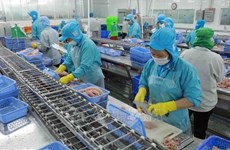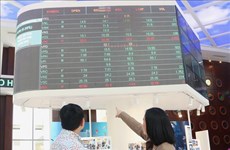Vietnam sees economic recovery on the horizon
Le Quoc Phuong, Deputy Director of the Vietnam Industry and Trade
Information Centre, talked to the Vietnam News Agency about the
country's trade surplus in 2014 and the challenges it may face in 2015.
Le Quoc Phuong, Deputy Director of the Vietnam Industry and Trade
Information Centre, talked to the Vietnam News Agency about the
country's trade surplus in 2014 and the challenges it may face in 2015.
*The growth in exports was 14 percent higher than last year, helping Vietnam to gain a trade surplus of 2 billion USD. Is this a highlight of the country's economy, in your opinion?
This trade achievement is surely an economic highlight in 2014. In the context that the global economy is dull, in general, and Vietnam, in particular, is struggling with difficulties, the 14 percent export growth is a remarkable performance. Furthermore, the ratio of the manufacturing and processing industry in the export structure has been positively increasing within the last few years, while the ratios of the agriculture, forestry and fisheries products and the fuels-mineral resources industry both decreased.
The import activity was also monitored quite effectively in 2014.
Accordingly, the import-favoured products, such as equipment and materials, made up nearly 90 percent of the total imports, while products in need of close monitoring or limited imports averaged less than 5 percent each.
Furthermore, 2014 is the third year in a row that Vietnam had a trade surplus after several years with trade deficits.
*How will those numbers affect the macroeconomic balances?
In my opinion, trade in 2014 had an active impact on the macroeconomic balances of Vietnam. With a growth of 14 percent higher than last year, exports provided a helping hand that promoted economic growth, which was expected to measure about 5.8-5.9 percent this year. The trade surplus of 2 billion USD did not only improve the balance of trade and the balance of payments, but also helped increase the national foreign-exchange reserves to a record of more than 35 billion USD.
In addition to that, the trade surplus stabilised the exchange rates, which partially led to the success of the inflation-control target.
*What are the negative aspects of trading in 2014?
Though the export volume was high, added value was still relatively low.
Most of the exports in the agriculture, forestry and fisheries and fuels-mineral resources industries were raw products, so the added value was minor despite the high quantity. Meanwhile, export products in the manufacturing and processing industry, such as mobile phones, textiles and foot wear, also had low added value, as most came off the assembly lines.
Secondly, the export growth mainly depended on the FDI (foreign direct investment) enterprises, as their exports made up more than two thirds of the country's total exports. The remaining one third came from domestic enterprises. The trade surplus also rose due to the help of the FDI enterprises, while the domestic businesses showed a trade deficit. Those facts indicated that domestic enterprises are becoming weaker compared to the FDI enterprises in terms of export volumes, export growth rates and the trade balance, as well.
The third difficulty was the dangerously high dependence upon a very few export markets. Our five largest export markets (the US, EU, ASEAN, Japan, China) accounted for more than 70 percent of Vietnam's total exports, while the top six import markets (China, ASEAN, the Republic of Korea, Japan, EU, the US) was responsible for about 80 percent of our total imports. The dependence on China was particularly high, as nearly 30 percent of our imports came from China. Relying too much on a few markets is very risky, especially when a disadvantaged factor appears in those markets.
Another problem was the export-to-GDP ratio, which has climbed to over 80 percent. This figure showed that the country's economy was open, but also was depending too much on exports. This could make the economy become vulnerable when global trade drops.
*What are the advantages of and challenges to Vietnam's trading in 2015? Will we be able to maintain the trade surplus?
Vietnam has recorded a trade surplus over three continuous years since 2012, but I doubt that we can do the same in 2015. We have to acknowledge that the trade surplus was only achieved due to our poor economic situation. The decreases in both investment and consumption led to the relative decline of imports against exports, resulting in a trade surplus over the last three years.
The Vietnamese economy is showing signs of recovery in 2015, which means that the investment needs of enterprises for manufacturing expansion is very likely to increase and so will the demand by consumers. Those increases are bound to lead to higher import volumes and the trade deficit is expected to make its return.
Moreover, to prepare for the Trans-Pacific Partnership (TPP) agreement, which is to be signed in 2015, many foreign investors will jump into supporting industries in Vietnam, especially in particular sectors such as textiles and foot wear, to meet the rules of origin, as called for in the TPP. Hence, the demand for importing machinery and equipment will strongly increase, which is also a factor that causes a trade deficit.
We should not worry much about the trade deficit, as many other emerging countries also have trade deficits due to their needs for investments to fund their development. In Vietnam, the trade deficit actually is caused by our economic recovery.
*What should the Government do to effectively monitor imports and the trade deficit?
The Government should develop a policy that promotes the development of the supporting industry by encouraging more small and medium-sized enterprises (SMEs) to take part in the game. Experiences in Japan, the Republic of Korea and Malaysia prove that those SMEs played a very important role in establishing a supporting industry.
Policy reforms covering taxes and customs barriers, for example, should be carried out to reduce the costs of the enterprises, therefore strengthening their competitiveness in the markets. Imports should also be placed under controls that encourage import-favoured products, while restraining the importing of products listed as in need of close monitoring or limiting imports.-VNA
*The growth in exports was 14 percent higher than last year, helping Vietnam to gain a trade surplus of 2 billion USD. Is this a highlight of the country's economy, in your opinion?
This trade achievement is surely an economic highlight in 2014. In the context that the global economy is dull, in general, and Vietnam, in particular, is struggling with difficulties, the 14 percent export growth is a remarkable performance. Furthermore, the ratio of the manufacturing and processing industry in the export structure has been positively increasing within the last few years, while the ratios of the agriculture, forestry and fisheries products and the fuels-mineral resources industry both decreased.
The import activity was also monitored quite effectively in 2014.
Accordingly, the import-favoured products, such as equipment and materials, made up nearly 90 percent of the total imports, while products in need of close monitoring or limited imports averaged less than 5 percent each.
Furthermore, 2014 is the third year in a row that Vietnam had a trade surplus after several years with trade deficits.
*How will those numbers affect the macroeconomic balances?
In my opinion, trade in 2014 had an active impact on the macroeconomic balances of Vietnam. With a growth of 14 percent higher than last year, exports provided a helping hand that promoted economic growth, which was expected to measure about 5.8-5.9 percent this year. The trade surplus of 2 billion USD did not only improve the balance of trade and the balance of payments, but also helped increase the national foreign-exchange reserves to a record of more than 35 billion USD.
In addition to that, the trade surplus stabilised the exchange rates, which partially led to the success of the inflation-control target.
*What are the negative aspects of trading in 2014?
Though the export volume was high, added value was still relatively low.
Most of the exports in the agriculture, forestry and fisheries and fuels-mineral resources industries were raw products, so the added value was minor despite the high quantity. Meanwhile, export products in the manufacturing and processing industry, such as mobile phones, textiles and foot wear, also had low added value, as most came off the assembly lines.
Secondly, the export growth mainly depended on the FDI (foreign direct investment) enterprises, as their exports made up more than two thirds of the country's total exports. The remaining one third came from domestic enterprises. The trade surplus also rose due to the help of the FDI enterprises, while the domestic businesses showed a trade deficit. Those facts indicated that domestic enterprises are becoming weaker compared to the FDI enterprises in terms of export volumes, export growth rates and the trade balance, as well.
The third difficulty was the dangerously high dependence upon a very few export markets. Our five largest export markets (the US, EU, ASEAN, Japan, China) accounted for more than 70 percent of Vietnam's total exports, while the top six import markets (China, ASEAN, the Republic of Korea, Japan, EU, the US) was responsible for about 80 percent of our total imports. The dependence on China was particularly high, as nearly 30 percent of our imports came from China. Relying too much on a few markets is very risky, especially when a disadvantaged factor appears in those markets.
Another problem was the export-to-GDP ratio, which has climbed to over 80 percent. This figure showed that the country's economy was open, but also was depending too much on exports. This could make the economy become vulnerable when global trade drops.
*What are the advantages of and challenges to Vietnam's trading in 2015? Will we be able to maintain the trade surplus?
Vietnam has recorded a trade surplus over three continuous years since 2012, but I doubt that we can do the same in 2015. We have to acknowledge that the trade surplus was only achieved due to our poor economic situation. The decreases in both investment and consumption led to the relative decline of imports against exports, resulting in a trade surplus over the last three years.
The Vietnamese economy is showing signs of recovery in 2015, which means that the investment needs of enterprises for manufacturing expansion is very likely to increase and so will the demand by consumers. Those increases are bound to lead to higher import volumes and the trade deficit is expected to make its return.
Moreover, to prepare for the Trans-Pacific Partnership (TPP) agreement, which is to be signed in 2015, many foreign investors will jump into supporting industries in Vietnam, especially in particular sectors such as textiles and foot wear, to meet the rules of origin, as called for in the TPP. Hence, the demand for importing machinery and equipment will strongly increase, which is also a factor that causes a trade deficit.
We should not worry much about the trade deficit, as many other emerging countries also have trade deficits due to their needs for investments to fund their development. In Vietnam, the trade deficit actually is caused by our economic recovery.
*What should the Government do to effectively monitor imports and the trade deficit?
The Government should develop a policy that promotes the development of the supporting industry by encouraging more small and medium-sized enterprises (SMEs) to take part in the game. Experiences in Japan, the Republic of Korea and Malaysia prove that those SMEs played a very important role in establishing a supporting industry.
Policy reforms covering taxes and customs barriers, for example, should be carried out to reduce the costs of the enterprises, therefore strengthening their competitiveness in the markets. Imports should also be placed under controls that encourage import-favoured products, while restraining the importing of products listed as in need of close monitoring or limiting imports.-VNA













